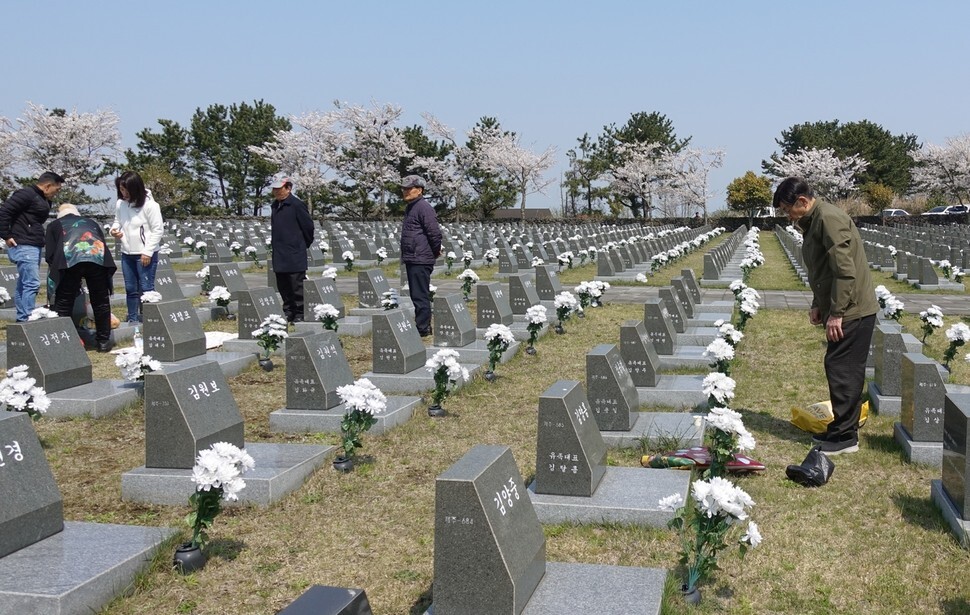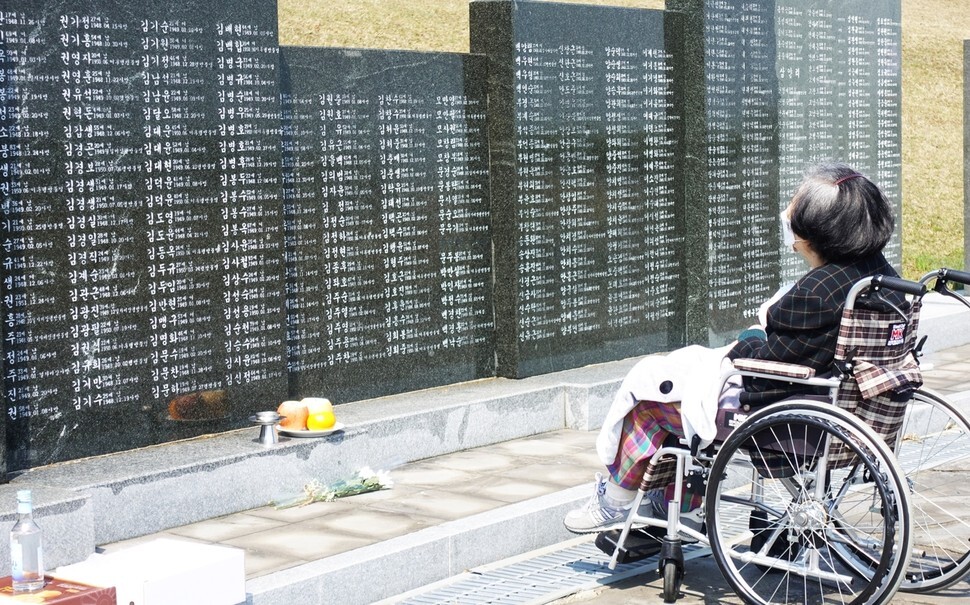hankyoreh
Links to other country sites 다른 나라 사이트 링크
[Reportage] Over 5,000 Jeju Massacre victims’ remains have yet to be found

“I came here because I had heard that my uncle went missing in Incheon Prison, but the ‘Additional Jeju April 3 Incident Investigation Report’ says differently. Is this record correct?”
Kim Jeong-yong, a 64-year-old resident of Uigwi village in the Namwon township of Seogwipo, had a flushed expression on his face as he inquired about his uncle’s whereabouts on Apr. 1. Previously, Kim had been told that his uncle Kim Yun-il went missing while incarcerated at Incheon Prison during the events of the Jeju Massacre of April 3. But the additional investigation report published by the Jeju 4/3 Peace Foundation indicated that the uncle had disappeared following a preliminary arrest at the time of the Korean War.
“In 1977, I successfully applied to join the Marines, and I was visited twice by the local police branch for a background check,” Kim recalled. “My father, who was a schoolteacher at the time, argued with the police at the time, telling them that his brother [Kim’s uncle] had disappeared after going to Incheon Prison during the events of Jeju April 3, but that he ‘didn’t know any more than that.’”
Kim explained that he did not make any attempt afterwards to learn about his uncle’s fate.
“How could they ask someone to cancel enlistment?” he wondered.

Kim’s uncle had been attending Seogwi Middle School when he was sentenced to five years in prison at a July 1949 court-martial. He served time in Incheon Prison before returning home when the prison was opened soon after the Korean War erupted. But on Aug. 18, 1950, he was taken in a preliminary arrest and held in a warehouse of the Seogwi agricultural association. His subsequent fate remains unknown. In exhumations in the Jeju Airport area between 2007 and 2009, around 380 sets of remains were uncovered together. Based on analyses of family members’ DNA, a portion of them were found to belong to preliminary arrestees from the Seogwipo area who had gone missing.
“Now that I know what happened to my uncle, I plan to provide a blood sample and do everything I can to locate his remains through DNA identification,” Kim said.
While some residents of Jeju’s mountainous areas hid deep in the mountains during the events of Jeju April 3, others fled to different regions. Soldiers and police pressed family members to find their children and spouses who had taken refuge; many places saw “proxy massacres,” in which family members were executed in their stead.

Most of the 2,550 prisoners -- including around 200 from regular trials and 2,350 from two sets of military courts-martial in 1948-1949 -- went missing soon after the outbreak of the Korean War without ever having a chance to return to their hometown. Already facing the stigma of being viewed as “communist families,” their surviving kin never even considered looking into their fate.
In its full-scale examination of the death toll in the individual villages of Jeju’s towns and townships for the additional investigation, the foundation found that many of the missing had been processed as deceased -- including cases of victims who succumbed to illness or otherwise died in prison but whose remains were never returned, victims whose remains were never located after they were sentenced to death by court-martial and shot, and victims whose remains were never found but who were reported as dead.
A 2003 investigation report by the South Korean government listed the number of missing persons from Jeju April 3 at 3,171. As of late 2019, that number had risen to 3,610 based on additional reports by victims and family members. The foundation’s additional investigation brought the total number of missing persons up to 4,255. Besides the 2,073 who went missing while incarcerated in other regions and 305 classified as “other missing,” the remaining 1,877 were found to have disappeared within Jeju Island.
Among them, 1,022 disappeared after being captured by punitive forces; 170 disappeared after being captured by guerrillas; 188 went missing after being sentenced to death; and 497 went missing after preliminary arrest.
“This additional investigation provided a more concrete picture of the disappearance situation, including a number of cases where individuals had been reported as dead but who were actually unaccounted for,” explained Cho Jeong-hee, deputy director of the Jeju 4/3 Peace Foundation investigation and research office and current commemorative project team director.
“The total number of people unaccounted for is estimated at over 5,000. We will need to focus our efforts on tracking down their whereabouts based on prisoner registers and National Archives of Korea prisoner records,” Cho said.
By Huh Ho-joon, staff reporter
Please direct comments or questions to [english@hani.co.kr]
Editorial・opinion
![[Column] Has Korea, too, crossed the Rubicon on China? [Column] Has Korea, too, crossed the Rubicon on China?](https://flexible.img.hani.co.kr/flexible/normal/500/300/imgdb/original/2024/0419/9317135153409185.jpg) [Column] Has Korea, too, crossed the Rubicon on China?
[Column] Has Korea, too, crossed the Rubicon on China?![[Correspondent’s column] In Japan’s alliance with US, echoes of its past alliances with UK [Correspondent’s column] In Japan’s alliance with US, echoes of its past alliances with UK](https://flexible.img.hani.co.kr/flexible/normal/500/300/imgdb/original/2024/0419/2317135166563519.jpg) [Correspondent’s column] In Japan’s alliance with US, echoes of its past alliances with UK
[Correspondent’s column] In Japan’s alliance with US, echoes of its past alliances with UK- [Editorial] Does Yoon think the Korean public is wrong?
- [Editorial] As it bolsters its alliance with US, Japan must be accountable for past
- [Guest essay] Amending the Constitution is Yoon’s key to leaving office in public’s good graces
- [Editorial] 10 years on, lessons of Sewol tragedy must never be forgotten
- [Column] A death blow to Korea’s prosecutor politics
- [Correspondent’s column] The US and the end of Japanese pacifism
- [Guest essay] How Korea turned its trainee doctors into monsters
- [Guest essay] As someone who helped forge Seoul-Moscow ties, their status today troubles me
Most viewed articles
- 1[Column] The clock is ticking for Korea’s first lady
- 2After 2 months of delayed, denied medical care, Koreans worry worst may be yet to come
- 3Hong Se-hwa, voice for tolerance whose memoir of exile touched a chord, dies at 76
- 4[Column] Has Korea, too, crossed the Rubicon on China?
- 5[Correspondent’s column] In Japan’s alliance with US, echoes of its past alliances with UK
- 6Samsung barricades office as unionized workers strike for better conditions
- 7All eyes on Xiaomi after it pulls off EV that Apple couldn’t
- 8[Editorial] As it bolsters its alliance with US, Japan must be accountable for past
- 9[News analysis] After elections, prosecutorial reform will likely make legislative agenda
- 10US overtakes China as Korea’s top export market, prompting trade sanction jitters